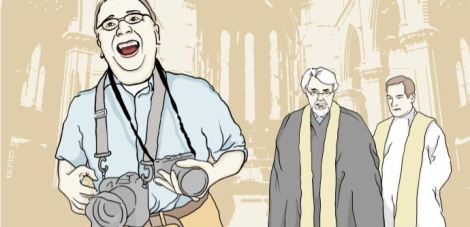Cameras and photography are as much a part of our holidays today as shouting at bemused locals in the hope of being understood was thirty years ago. Whether it be a smartphone’s built-in camera, a pocket sized point-and-shoot, or a bulky SLR with telescopic lens and it’s very own carry bag, everyone travels with a camera.
The advantages are inexhaustible. We can now return weary from our overseas adventures and regale our family and friends with fantastical stories coloured by hi-res pictures of ancient ruins and weather-beaten locals. In addition we can now store these memories across a variety of mediums, order high quality, low cost prints to frame on our walls, store them digitally on portable hard drives for future reference – we can even create DVD slideshows to sit back and reminisce in front of in years to come.
This evidence clearly points to a golden age of amateur photography.
There is, however, a downside. What was once a pleasant stroll through time on a balmy afternoon in Rome becomes a stress-ridden quest to find that perfect shot. Where once we might have sat in slack-jawed amazement at the architectural prowess of the ancients, we now set ourselves, one knee to the floor, camera in hand, impatiently waiting for the over-50s tour group to shuffle off and leave us with a clear panorama of the vestiges of ancient civilisation.
It would be fair to say we are all guilty of this from time to time. Whether we are presented with one of the wonders of the modern world, one of the world’s biggest pop acts or a particularly handsome plate of Penne All’Arrabbiata, we often get a Pavlovian impulse to reach for our camera and preserve the image before us in perpetuity.
But why do we do this?
How often have we shared one of these masterpieces of which we are so proud with friends or family for them to be met with gasps of astonishment and genuine, persisting enthusiasm?
Not often, one wagers. Whilst this is what our egos crave, our photographic endeavours are in fact much more likely to attain an approving raised eyebrow, a casual nod or, if we’ve taken the necessary routes, a ‘Like’ or ‘Retweet’. Slim pickings indeed.
But this is losing sight of why we are in the position to take these snaps in the first instance. Not one of us looks at brochures of Athens thinking that we’d love to take our own photograph of the Parthenon. No right-minded music lover would buy tickets to see the Rolling Stones with the express hope of capturing a grainy shot of Mick Jagger’s gyrating hips, and surely no eager diner decides on a visit to a particular restaurant with the direct motive of gaining the endorsement of their Instagram followers.
Not only do the means by which we capture these images often prove to outweigh the satisfaction and acclaim the final product achieves, but often they can distress those whose homes we visit.
The congregants of the Church of the Holy Sepulchre, Jerusalem (one of the holiest and most important sites in the Christian world) cut sombre, disappointed and at times downright dismayed figures as tourists from all four corners of the world point cameras at everything and anything in the building.
As worshippers solemnly kneel before the Altar of the Crucifixion and utter their thanks they are lit harshly and intermittently by the flashes of dozens of visiting cameras. In some cases these cameras are thrust beyond the rope boundary of the altar and into the unexpecting congregant’s face as they attempt to speak to their God.
A complete photography amnesty within holy buildings and even historic sites would possibly be a rather heavy handed approach, but it would at least afford the respect these monuments and their patrons are entitled to. In lieu of these measures one would encourage a casual policy of dignified deference, where before taking up our cameras on these hallowed grounds we take a moment to think whether that shot is worth the disruption it will cause.
It is natural to wish to share our experiences with those we care about, but there are times when it is better to allow yourself to enjoy the moment. Sit back and gaze up at the 2nd century stonework, feel your feet stepping on the very cobbles those 16th century merchants would have rushed over and feel overcome by the rich atmosphere that can wash over one in such rich surroundings. Life is for living, not ‘liking’.
Chris Platt
@ChrisBradman
